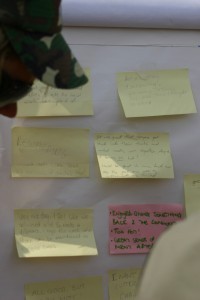Brainstorming – Coming Up With Useable Ideas, pt. 4
We’ve discussed creating a place to keep your ideas, finding a central idea, and the secret of creating obstacles. Now we’ll tackle some brainstorming methods so you can start filling out your story with ideas.
Post-it Board

Post-it Notes on the White Board by Drew Leavy, flickr.com CC Attribution/No Derivatives license
My favorite way to brainstorm is a medium-sized whiteboard and Post-its. I’ll jot down ideas on the Post-its and stick them to the board. My favorite time of day to do this is in commercials of my favorite shows.
Sometimes I make pretty designs out of the Post-its, but most of the time I line them up in rows. Or use a mind mapping method, outlined below.
Big, small, weird, or mundane – every idea goes up. One idea usually leads to another. Sometimes I combine them together. After I collect a board full of Post-its, I go back and write them down in my story file, usually in Scrivener’s notecard function.
I find a physical whiteboard works the best for me, but some alternatives can include:
Scrivener’s notecard function
Free sticky note software such as Stickies (PC), Sketchbox (Mac), Sticky Notes !
 (Android), and Sticky (iPad).
(Android), and Sticky (iPad).3×5 notecards (which you can keep in your story file, if you want)
Websites like Padlet or lino
Mind mapping

NPR Mind Map by Chris Gladis, flickr.com CC Attribution license
Mind mapping is a method of visually brainstorming by creating bubbles of thoughts around a thought, and then branching out from there.
I am too linear of a thinker to find mind mapping that helpful, but many people I know use it with great results. Some make amazing doodles and designs on their mind maps.
Lifehacker has an excellent list of mind mapping software, though a pencil and a piece of paper might work even better, and something you can do even if you are out and about.
Listing
Listing is underrated in my opinion. I still find it the easiest way to generate ideas quickly.
I often list at the beginning of a chapter, jotting down some thoughts on what needs to happen or what could happen. I also write down questions about the characters or the story, or single words and emotions.
I tend to use PiratePads for listing outside of Scrivener, but sometimes I write on a physical whiteboard as well.
Workflowy is an outlining app that many use for listing and outlining. It’s super easy to write quick lists and keep them handy, along with creating outlines for your stories. Workflowy is accessible on just about every device, so you can make notes from anywhere.
Pace and Talk
I have Dragon NaturallySpeaking , and though I find it awkward to write drafts, I do like to walk around my office and talk out ideas. Some of it might be a little garbled, but since its notes, it doesn’t really matter.
, and though I find it awkward to write drafts, I do like to walk around my office and talk out ideas. Some of it might be a little garbled, but since its notes, it doesn’t really matter.
Creative Visualization
Creative visualization can also be used with Dragon NaturallySpeaking or a digital recorder, but you might find other physical methods distracting.
Here’s my method of creative visualization. Custom tailor your experience to suit your personality and style.
Turn out the lights in the room and draw the shades. It doesn’t have to be pitch dark, just low light.
Turn on Songza’s Post-Rock Bliss station or one of the other instrumental stations. Keep the volume soft.
Lean back in a comfortable chair, feet up, and begin imagining your characters.
Put your characters through some scenarios (have a little card with these questions, if you need to):
Your main character’s biggest fear comes to haunt them. What is it? What do they do? What is their first action of self protection? What would it take for them to face and challenge it?
Your antagonist finds your main character to taunt them. The antagonist starts listing how they will throw obstacles in your protagonist’s path. What are they? What is the worst thing they could do to punish the main character?
Your main character and allied secondary characters are in a room together. How do they go about trying to come up with a plan to defeat the bad guy or a big obstacle? How do they differ? Get them really arguing about it. Hear their voices and pick out small mannerisms that make them different from the other characters.
Take A, B, and C, and put your secondary characters in those places. Who is their antagonist? What is their biggest fear?
Coming Up
Next week, the last in our series on idea generation, we’ll be tackling some ways to create depth and how to keep reader interest in the storyline. And for our last post in this series, I will develop a whole new story using these techniques.
Related Posts:
Fight The Biggest Monster – Coming Up With Useable Ideas, pt. 3
Write What You Like – Coming Up With Useable Ideas, pt. 2
The Idea Game – Coming Up With Useable Ideas, pt. 1
Original article: Brainstorming – Coming Up With Useable Ideas, pt. 4.
If you would like to receive freebies, discounts, and updates about new books, sign up for my newsletter at the top right of my website.



